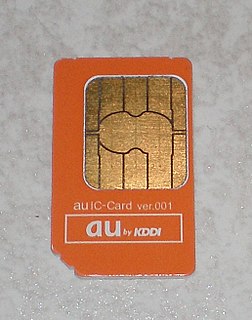EUIMID (expanded UIMID) is a unique identifier for an R-UIM (Removable User Identity Module) or CSIM (CDMA SIM application) card in CDMA2000 cellular systems that replaces the older UIMID identifier. There are two forms of EUIMID, known as Short Form (SF_EUIMID) and Long Form (LF_EUIMID). Both produce a 32-bit pseudo-UIMID (pUIMID) with 0x80 in the upper 8 bits and the least significant 24 bits of the SHA-1 hash of the entire SF_EUIMID or the entire ICCID EF (for LF_EUIMID) in the lower 24 bits.
A UIMID is a 32-bit Electronic Serial Number (ESN) stored in a R-UIM or CSIM used for TDMA or CDMA2000 phones. It is given a different name to avoid confusion with the hardware ESN stored in the phone. In all known systems the UIMID displaces the ESN in signaling. Because the UIMID is allocated from the same numbering space as ESN its existence is transparent to the network. The reason the UIMID is transmitted instead of the ESN is because the card contains the MIN or IMSI and devices such as the HLR running the ANSI-41 mobility management protocol insist on a static association between these identifiers for subscription validation. The HLR will store the MIN or IMSI alongside the ESN in each record, and if an ANSI-41 message is received containing a different pair it will be rejected as invalid.
With reference to a given set of objects, a unique identifier (UID) is any identifier which is guaranteed to be unique among all identifiers used for those objects and for a specific purpose. There are four main types of unique identifiers, each corresponding to a different generation strategy:
- serial numbers, assigned incrementally or sequentially
- random numbers, selected from a number space much larger than the maximum number of objects to be identified. Although not really unique, some identifiers of this type may be appropriate for identifying objects in many practical applications and are, with abuse of language, still referred to as "unique"
- names or codes allocated by choice which are forced to be unique by keeping a central registry such as the EPC Information Services.
- names or codes allocated using a regime involving multiple (concurrent) issuers of unique identifiers that are each assigned mutually exclusive partitions of a global address space such that the unique identifiers assigned by each issuer in each exclusive address space partition are guaranteed to be globally unique. Examples include (1) the media access control address MAC address uniquely assigned to each individual hardware network interface device produced by the manufacturer of the devices, (2) consumer product bar codes assigned to products using identifiers assigned by manufacturers that participate in GS1 identification standards, and (3) the unique and persistent Legal Entity Identifier assigned to a legal entity by one of the LEI registrars in the Global Legal Entity Identifier System (GLEIS) managed by the Global LEI Foundation (GLEIF).

CDMA2000 is a family of 3G mobile technology standards for sending voice, data, and signaling data between mobile phones and cell sites. It is developed by 3GPP2 as a backwards-compatible successor to second-generation cdmaOne (IS-95) set of standards and used especially in North America and South Korea.
Contents
The EUIMID (and UIMID) are hardware identifiers that do not change throughout the life of the card they identify. Their most important characteristic is that they are globally unique, no two R-UIM or CSIM cards should ever be given the same number. Secondly, they can identify the issuer of the code (likely a mobile phone operator in the case of LF_EUIMID, and an R-UIM or CSIM card manufacturer in the case of SF_EUIMID). The pseudo-UIMID is not unique, but can satisfy most uses of UIMID. Where this is not possible, or not desirable, another unique identifier (such as EUIMID) should be used instead or the requirement for uniqueness should be removed.





